Are you a Quiet Speculation member?
If not, now is a perfect time to join up! Our powerful tools, breaking-news analysis, and exclusive Discord channel will make sure you stay up to date and ahead of the curve.
My Saturday morning kicks off a lot like yours. I roll out of bed, throw on some Future, have a latte. Get on Facebook. Then, my inbox starts exploding. "Is Modern dead?" “How do you feel about the ban?” Dead? What ban? Wait, there are links. Links from Magic players I’ve never met. The same link, multiple times. I click the link and read. Faster and faster, missing chunks of text. Missing entire paragraphs. I’ll just go back to them later. I reach the end.
"In the interest of competitive diversity, Splinter Twin is banned from Modern.”
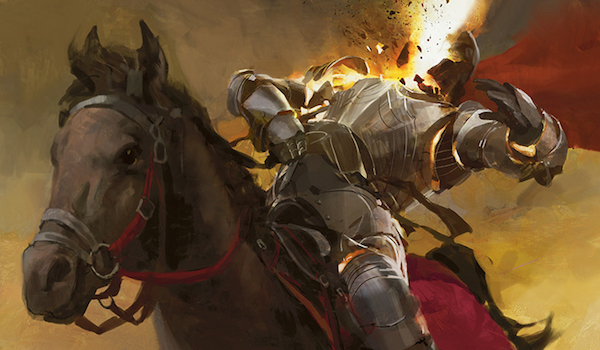
How do I feel about the ban? I don’t know how I feel about it. I’m having many feelings right now. I need some time to think. Let me get back to you.
It’s been six days, and I’ve thought about the Splinter Twin ban. I’ve also read and heard about it. All week. It seems like Modern players think this ban is about the Pro Tour. They call it unfair and premature. They don’t believe Twin had it coming.
I feel the opposite way. Wizards' January 18th announcement outlines a number of causes for the Splinter Twin ban, and they check out. This article explores the viability of Wizards' rationales, dissects unofficial reasons for the ban, and forecasts the future of Modern.
[wp_ad_camp_1]
Processing the Pre-Ban Metagame
Before discussing whether Wizards was justified in their banning of Splinter Twin, we'll check out the most recent Modern Nexus metagame breakdown, from January 6th, 2016. Visualizing the pre-ban metagame should give us an idea of Wizards' view of Modern.
I've organized the Tier 1 and 2 decks into six categories, coloring interactive decks green and linear decks orange. We'll refer to this chart throughout the article.
BGx, URx, and Linear City
Modern decks have historically identified with one of three camps. BGx combines flexible removal, catch-all discard spells, and efficient beaters to grind out fair decks and pick apart synergies. These decks include Jund, Abzan, and the more aggro-aligned Abzan Company. URx gets the awesome power of Bolt-Snap-Bolt, Blood Moon, and stack interaction. UR Twin, Grixis Midrange, and my beloved RUG Delver all huddle under the URx umbrella.
BGx and URx represent Modern's pillars of interaction. If you want to interact in this format, you almost always sleeve up one or the other. A spattering of unique decks (Merfolk, Zoo, etc.) comprises a third interactive category, which doesn't fall into BGx or URx. These archetypes have usually occupied a minority share in Modern, even taken together. We can call just about everything else in Modern "linear."
Twin's Banning, According to Wizards
In their January 18th banlist announcement, Wizards gave several justifications for the Splinter Twin ban. This section analyzes each. In keeping with its other banlist announcements, the company chose its words carefully and appeared purposefully cryptic in some of its language. That language is all we get with these kinds of announcements, so it's crucial to carefully dissect the text if we want to fully understand the announcement.
Metagame Presence
"We also look for decks that hold a large enough percentage of the competitive field to reduce the diversity of the format."
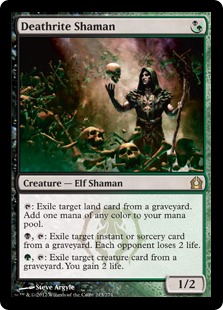 Metagame presence bans are well-documented in Modern. Deathrite Shaman, Bloodbraid Elf, Birthing Pod, and Treasure Cruise all crumbled under the banhammer because they helmed ubiquitous decks.
Metagame presence bans are well-documented in Modern. Deathrite Shaman, Bloodbraid Elf, Birthing Pod, and Treasure Cruise all crumbled under the banhammer because they helmed ubiquitous decks.
Let's consult the January 6th breakdown. Combined, the Tier 1 and Tier 2 Splinter Twin strategies make up 11.5% of the metagame. That's only 3.3% higher than Affinity, at 8.2%, and about even with BGx Midrange decks, at 11.8%. But we're not seeing a Liliana of the Veil ban.
Twin doesn't seem that offensive to me on the metagame dominance count, so I don't love the inclusion of this sentence in Wizards' announcement. In terms of writing composition, it serves to bridge "gracefully" from explaining the Summer Bloom ban to detailing the Twin ban. Realistically, all it does is confuse players who look at the numbers. Splinter Twin just doesn't make up an influential chunk of Modern compared with past offenders. Moreover, Twin has often hovered around 10% representation in Modern. Wizards hasn't banned it for this reason before, so it makes little sense to ban it for this reason now, especially considering Modern's recent shifts and the looming Eldrazi future.
It appears from the rest of the announcement that metagame dominance is not the primary reason Wizards banned Splinter Twin.
Winning Too Much
"Antonio Del Moral León won Pro Tour Fate Reforged playing Splinter Twin, and Jelger Wiegersma finished third; Splinter Twin has won two of the four Modern Pro Tours. Splinter Twin reached the Top 8 of the last six Modern Grand Prix. The last Modern Grand Prix in Pittsburgh had three Splinter Twin decks in the Top 8, including Alex Bianchi's winning deck."
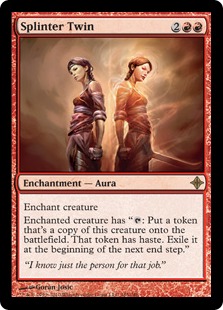 Many Modern players consider this excerpt the scariest part of Wizards' announcement, and I think it's the reason for most of the outrage related to the ban. If Splinter Twin gets banned for "winning too much," doesn't Modern become an environment where players root against their own decks for fear of a ban on their own expensive 75? In that case, doesn't this announcement set a paranoid tone for Modern and encourage ban-mania?
Many Modern players consider this excerpt the scariest part of Wizards' announcement, and I think it's the reason for most of the outrage related to the ban. If Splinter Twin gets banned for "winning too much," doesn't Modern become an environment where players root against their own decks for fear of a ban on their own expensive 75? In that case, doesn't this announcement set a paranoid tone for Modern and encourage ban-mania?
I don't think so. After all, banning the winningest deck is nothing new in Modern. Many Twin players I've spoken with, and read, erroneously consider the ban on their namesake card unprecedented. In fact, Modern boasts a rich history of banning decks that succeed too much in Wizards' eyes. Take this quote, from the Birthing Pod ban announcement:
"Over the past year, Birthing Pod decks have won significantly more Grand Prix than any other Modern decks and compose the largest percentage of the field. [...] Pod won five of the twelve Grand Prix over the past year, including winning the last two."
Wizards cares about how well decks perform, and how many Top 8 slots they take up over the course of a given year. The evidence above, like that from the Twin announcement, is restricted to a few sentences. Wizards writes so sparingly on the subject because they've already dedicated three paragraphs to this position, back when they banned Bloodbraid Elf:
"[...] Jund has been the most successful deck at high-level tournaments. Yuuya Watanabe won the Magic Player's Championship playing Jund. Then, Yuuya came in 2nd at Pro Tour Return to Ravnica by playing Jund again.
At that point, it was clear Yuuya was dominating, but the status of Jund in Modern was less clear.
Since then, we have had four Modern Grands Prix. Jérémy Dezani won Grand Prix Lyon playing Jund. Jacob Wilson defeated Josh Utter-Leyton in a Jund-on-Jund finals to win Grand Prix Chicago. Willy Edel won Grand Prix Toronto, also playing Jund. And, finally, Lukas Jaklovsky came in 2nd, playing Jund, at Grand Prix Bilbao. Beyond that, Jund took six of the Top 16 decks at Bilbao."
R&D wouldn't include such an expansive history lesson in a banlist announcement unless it desperately wanted to tell us something: decks that win too much get banned in Modern. Splinter Twin meets this criterion for a ban.
We don't know Wizards' exact parameters for "winning too much," but we at least have some data to mull over. Prior to the Twin ban, Birthing Pod got the axe in January 2015. The most recent ban at that point had been Deathrite Shaman's, in February 2014. Between each banning, we've had seven GPs to consult. I've analyzed each one to compare Twin's win ratio with Pod's.
2014 GPs: Richmond, Minneapolis, Boston-Worcester, Kobe, Madrid, Milan, Omaha
2015 GPs: Vancouver, Charlotte, Copenhagen, Singapore, Oklahoma City, Porto Alegre, Pittsburgh
Pod leads Twin in number of decks in all GP Top 8s for its ban cycle by just 5%, and in total number of GP wins by one. These two decks, during their respective cycles, are the only ones to win multiple GPs. Additionally, Pod was absent from the GP Boston-Worcester and the GP Kobe Top 8s. Splinter Twin, on the other hand, made at least one appearance in every GP Top 8 since the Pod ban. Notably, Twin hardly made a showing in 2014, holding a 0.7% Top 8 share and winning zero GPs.
"Winning too much" may be a vague, debatable measure for us, but these numbers indicate that Wizards adheres to strict cutoff points when analyzing data. In comparing Twin’s results from the last year to Pod’s similar ones from the year before, that Wizards banned Twin for this reason becomes totally unsurprising.
Keeping Other Archetypes From Succeeding
"Decks that are this strong can hurt diversity by pushing the decks that it defeats out of competition."
It stands to reason t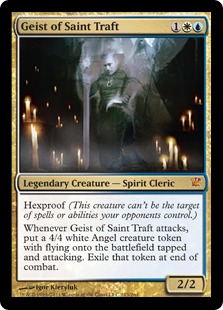 hat if Twin by default occupies 18% of all major event Top 8 spots in a given year, the remaining 82% become more competitive, and fewer decks can make it in.
hat if Twin by default occupies 18% of all major event Top 8 spots in a given year, the remaining 82% become more competitive, and fewer decks can make it in.
From a brewing perspective, the Twin ban does open up deck design space. No more must players fear tapping out on turn three for Geist of Saint Traft or Domri Rade. Even if a URx player counters the spell, he won't just win on the next turn. Previously, decks with these cards were forced to leave mana up against URx unless their opponent graciously tapped down one of his three lands for a Serum Visions.
We obviously don't know what the Modern metagame will resemble without Twin. Neither does Wizards. But that's fine with them. They'd just like URx to give up some shares at the top tables.
Homogenizing URx
"[Decks that are this strong] can also reduce diversity by supplanting similar decks. For instance, Shaun McLaren won Pro Tour Born of the Gods playing this Jeskai control deck. Alex Bianchi won our most recent Modern Grand Prix playing a similar deck but adding the Splinter Twin combination. Similarly, Temur Tempo used to see play at high-level events but has been supplanted by Temur Twin."
This passage refers to the homogenization of URx, which Wizards correctly identifies as overwhelmingly packing the Splinter Twin combo.
In the January 6th metagame breakdown, the non-aggro linear decks are mostly Big Mana decks. Each flavor of Big Mana has its own fastlands - RG Tron uses the Tron lands, Amulet uses Karoos, and Eldrazi uses Eye of Ugin and Eldrazi Temple.
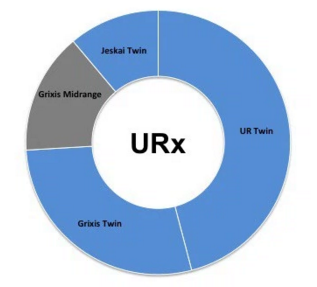 The three decks don't share a single card between them. As for the aggro decks, Affinity and Burn sit firmly at the top of the heap, but they don't exclude other unique strategies - Bogles, Merfolk, and Naya Company - from the top tiers. Like the Big Mana decks, each aggro strategy has its own set of staples.
The three decks don't share a single card between them. As for the aggro decks, Affinity and Burn sit firmly at the top of the heap, but they don't exclude other unique strategies - Bogles, Merfolk, and Naya Company - from the top tiers. Like the Big Mana decks, each aggro strategy has its own set of staples.
In BGx, things appear a little less diverse. Abzan Company totes a miserly 2.3% metagame share compared with Jund and Abzan's combined 11.8%. The URx section suffers from similar issues. Of the four decks, together represented at 13%*, only one - Grixis Midrange - omits the Splinter Twin combo. This deck clocks in at just 2%.
*I've included Scapeshift in its own interactive category, since RUG builds share their percentage here with toolbox-oriented Bring to Light ones. If we cut Scapeshift's 3.1% share in half, and add 1.5% to the URx bracket to account for RUG Scapeshift, Splinter Twin still shows up in a whopping 73% of all Tier 1 and 2 URx decks.
The recent breakdown numbers initially suggest Rock decks revolving around Liliana of the Veil and Abrupt Decay homogenize BGx as much as Splinter Twin homogenizes URx. But Wizards seldom bans cards for a single reason. Rock decks don't meet the other listed criteria for a ban, and Twin decks do.
Cards have been banned for this reason before. On December 20, 2011, Wizards banned Wild Nacatl from Modern for homogenizing aggro decks:
"We looked at our Modern tournaments and previous Extended tournaments to find when the attacking decks were fairly diverse, and when they were dominated by Zoo.
[...]
The problem is that other decks try to use synergy to get rewards, but those rewards aren't any better than the Wild Nacatl. For example, the Doran decks use Treefolk Harbinger to find Doran. When it all works, the Harbinger is effectively a 3/3 for ![]() . With shock lands, Wild Nacatl is a 3/3, and doesn't let you down when your opponent kills your Doran. With some effort, Student of Warfare becomes a 3/3 first strike creature, but that isn't a sufficient reward for the effort compared with Wild Nacatl. This creature is so efficient it is keeping too many other creature decks from being competitive. So, in the interest of diversity, the DCI is banning Wild Nacatl."
. With shock lands, Wild Nacatl is a 3/3, and doesn't let you down when your opponent kills your Doran. With some effort, Student of Warfare becomes a 3/3 first strike creature, but that isn't a sufficient reward for the effort compared with Wild Nacatl. This creature is so efficient it is keeping too many other creature decks from being competitive. So, in the interest of diversity, the DCI is banning Wild Nacatl."
Wizards eventually overturned the Wild Nacatl ban, but the banning still set a precedent for removing cards from Modern that homogenize certain archetypes. In the Twin ban announcement, Wizards mentions Shaun McLaren's Pro Tour Born of the Gods finish with Jeskai Control to make the same point. According to Wizards, the "rewards" of casting Splinter Twin in URx greatly outweigh those of trying to win with Spinx's Revelation or Huntmaster of the Fells, and come at a minimal deckbuilding cost to URx mages. Whether or not we agree with this assessment, Wizards has the numbers on their side; among Tier 1 and 2 Modern decks, Splinter Twin undeniably shows up in a remarkable portion of URx strategies.
Non-Announcement Reasons for the Ban
I’m not alone in wishing Wizards were more transparent about ban criteria. It’s a shame so many players felt blindsided by this announcement. As stated above, I don’t think Wizards swung the hammer clumsily this time, nor do I think they ever have. Still, more communication on their part would likely calm the Modern community’s angrier voices.
Naturally, increased transparency only goes so far. If Wizards painstakingly detailed every true reason for the Splinter Twin ban, and players had access to the company’s unadulterated expectations for Modern, the implications are scarier than the prospect of a yearly banning. Imagine Modern finances if every speculator knew months in advance which decks would be legal for the coming season. Modern would also become solved more quickly, and Wizards takes pride in the format’s apparent openness.
Twin wasn’t only banned for the reasons Wizards gave us. This section tackles some other factors that may have contributed to the decision.
Shaking Up Modern for the Pro Tour
I won’t spend much time on this section, since the idea of Wizards banning Twin just to shake up the Pro Tour has already been written about to death. But I will say that I disagree with this position, which goes like this: “We can’t have a solved Pro Tour format. Splinter Twin won two of the four Modern Pro Tours, and Wizards might want to keep the deck from winning more than half. Wizards will continue to ban cards before Pro Tours to make the event more interesting, without considering format health." In defense of this argument, Aaron Forsythe’s recent Twitter posts do admit a relationship between Modern bans and the Pro Tour, and suggest that bans will happen with higher frequency in Pro Tour formats.
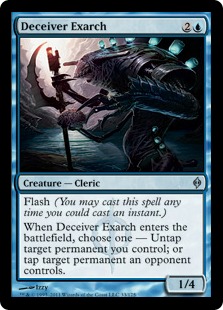 Corbin Hosler’s MTGPrice article displays these tweets in all their glory, and adds to them an important layer of commentary. Many Modern players have read Forsythe’s remarks as indicating the Twin ban only happened because of the upcoming Pro Tour. As evidenced throughout this article, Modern data and history both suggest this claim is untrue. Moreover, Forsythe himself refutes this idea, replying to an insinuation that Twin was banned only to hype the Pro Tour with: “That is a pretty imaginative interpretation of my response.”
Corbin Hosler’s MTGPrice article displays these tweets in all their glory, and adds to them an important layer of commentary. Many Modern players have read Forsythe’s remarks as indicating the Twin ban only happened because of the upcoming Pro Tour. As evidenced throughout this article, Modern data and history both suggest this claim is untrue. Moreover, Forsythe himself refutes this idea, replying to an insinuation that Twin was banned only to hype the Pro Tour with: “That is a pretty imaginative interpretation of my response.”
It can be difficult to articulate a complex position while respecting Twitter’s 140-character limit. I wish Forsythe had released his comments through a medium more conducive to total transparency, such as the Wizards website. That said, Modern players citing Forsythe’s comments as evidence that Wizards doesn’t care about the health of its darling format should re-read them.
Resisting Hate
Like Birthing Pod, Splinter Twin was nearly impossible to "hate out." Here's a tweet from Sam Black in response to the ban:
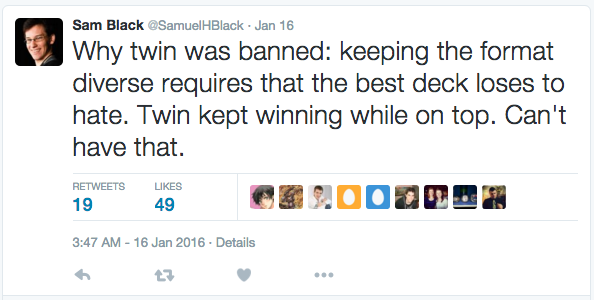
Modern's typically linear Big Mana decks - Tron, Bx Eldrazi, and formerly, Amulet Bloom - all lose to hate. Specifically, they lose to Blood Moon, a card that sees immense play across Modern for this reason. (To be clear, they lose to a combination of Blood Moon and pressure, or what I call "good Blood Moons.") Twin doesn't just not lose to Blood Moon, it wields the card masterfully. Wizards has probably watched Twin succeed with concern for awhile, printing eye-rollingly tactless checks like Rending Volley that ultimately did little to curb the deck's supremacy. I buy into Black's argument that Twin's resilience contributed to its banning. Notably, Black's opinions on the Twin ban have been explicitly endorsed by Aaron Forsythe.
Limiting Card Design Space
Cards like Preordain and Ancestral Vision have never been safe to come off the Modern banlist, and that predicament owes a lot to Splinter Twin's legality. Twin pilots would add these spells to their lists immediately, and Wizards' conservative policy doesn't unban cards that slot into existing top-tier decks. The case could be made that Twin's presence might prevent them from printing library manipulation, or other strong URx cards, in the future.
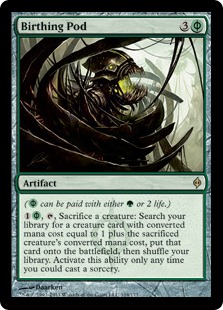 In their Birthing Pod ban announcement, Wizards confirmed that having Pod legal in Modern interfered with future creature design:
In their Birthing Pod ban announcement, Wizards confirmed that having Pod legal in Modern interfered with future creature design:
"Each year, new powerful options are printed, most recently Siege Rhino. Over time, this creates a growing gap between the strength of the Pod deck and other creature decks. [...] The high percentage of the field playing Pod suppresses decks, especially other creature decks, that have an unfavorable matchup. In the interest of supporting a diverse format, Birthing Pod is banned."
It's reasonable to blame Twin for Preordain's and Ancestral Vision's permanent resident status on the Modern ban list. Possibly, the deck's existence gives Wizards another reason not to reprint "control" cards like Counterspell for Modern.
Turn Four Rule Abuse and Breaking Interactive Shells
This position is my own, and therefore diverges from Wizards' ban announcement canon. While Modern has a turn four rule that Twin didn't violate, I think an interactive deck of its dexterity has no real business winning that quickly. Splinter Twin doesn't exemplify Modern's turn four rule - it abuses it.
 Birthing Pod gave BGx a robust, recursive engine. Pod decks jammed an infinite life/damage combo into an already resilient midrange shell, and enjoyed tremendous success in Modern during the card's legality. By the time Pod was banned, pilots had transitioned to combo-less, value-laden Siege Rhino builds. It became questionable to play a traditional BGx deck at all, as "splashing" copies of Birthing Pod gave these decks an entirely new angle of attack. Sure, Abzan had to run dorks to make it work, but a Pod would turn those dorks into Tarmogoyfs, then Kitchen Finks, then Siege Rhinos for the rest of the game. When Wizards banned Birthing Pod at the peak of its dominance, Abzan Midrange decks continued to police Modern.
Birthing Pod gave BGx a robust, recursive engine. Pod decks jammed an infinite life/damage combo into an already resilient midrange shell, and enjoyed tremendous success in Modern during the card's legality. By the time Pod was banned, pilots had transitioned to combo-less, value-laden Siege Rhino builds. It became questionable to play a traditional BGx deck at all, as "splashing" copies of Birthing Pod gave these decks an entirely new angle of attack. Sure, Abzan had to run dorks to make it work, but a Pod would turn those dorks into Tarmogoyfs, then Kitchen Finks, then Siege Rhinos for the rest of the game. When Wizards banned Birthing Pod at the peak of its dominance, Abzan Midrange decks continued to police Modern.
Splinter Twin gave URx decks a tool of similar potency, giving the fair, competent midrange shell a fairly consistent fourth-turn combo. Defendants of Twin in Modern argue that the deck exemplified the "turn four rule," since it never went off before then. Let's revisit Wizards' introduction of that rule:
"We used two criteria to guide us in choosing what cards to ban. First, we have a rule of thumb about Legacy that we don't like consistent turn-two combination decks, but that turn-three combination decks are okay. We modified that rule for Modern by adding a turn to each side: we are going to allow turn-four combination decks, but not decks that consistently win the game on turn three."
It seems to me that Wizards is specifically referring to combination decks. Any Splinter Twin pilot will tell you in a heartbeat that he's not playing a combination deck. Like Birthing Pod, Twin is a formidable interactive strategy that happens to have an oops-I-win. It doesn't make sense from a format design standpoint to have a deck like Splinter Twin exist, because it becomes incorrect to play a dedicated combo deck with the same turn four restriction. Twin "goes off" by the same time, but doesn't fold to hate, has mana to interact early in the game instead of setting up an elaborate combo kill, and polices Modern's faster linear decks.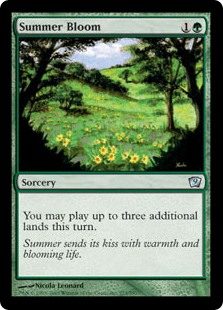 Summer Bloom was banned because it enabled the Amulet deck to consistently combo off on turn three. Assuming that ban didn't completely kill the deck, but instead made it consistently combo off on turn four, there would be no reason to play Bloom over Splinter Twin.
Summer Bloom was banned because it enabled the Amulet deck to consistently combo off on turn three. Assuming that ban didn't completely kill the deck, but instead made it consistently combo off on turn four, there would be no reason to play Bloom over Splinter Twin.
In my opinion, proficient interactive decks that house an instant-victory combo should not be able to reliably execute that combo on the same turn as dedicated combo decks. Based on their Pod and now Twin bans, Wizards may agree with me. Collected Company emerged as a poor man's Birthing Pod for one more mana, and now inhabits a similar shell in Modern. Wizards even points to a five-mana replacement for Splinter Twin in their banlist announcement:
"We considered what one would do with the cards from a Splinter Twin deck with Splinter Twin banned. In the case of some Jeskai or Temur, there are very similar decks to build. In other cases, there is Kiki-Jiki as a replacement."
Kiki-Jiki, Mirror Breaker pushes Twin's winning turn up by one, and complicates relying on both Cryptic Command and Blood Moon. It also allows opponents to disrupt the Twin combo with a hate card more widely played than even Moon itself - Lightning Bolt!
Modern's Twinless Future
The absence of Twin from the format should change the makeup of URx decks, but not how people feel about buying into Modern.
URx Without Splinter Twin
I'm not concerned about the viability of URx in Modern's future. RUG Scapeshift typifies a reasonable combo deck for Modern. It plays the same interactive cards as Twin, including Electrolyze and Snapcaster Mage. Sometimes, it even dips into tempo threats like Vendilion Clique for better beats. But the deck rarely wins before turn six, and that only happens with ramp effects that compromise the URx shell. Scapeshift also loses to dedicated hate. Unlike previous iterations of URx, it cannot rely on Blood Moon to defeat greedy opponents.
Should URx end up sucking, I can see Wizards releasing Splinter Twin from the banlist. After  all, there's a precedent for this kind of action, set with Wild Nacatl's unban in February 2014:
all, there's a precedent for this kind of action, set with Wild Nacatl's unban in February 2014:
"At the time Wild Nacatl was banned, we hoped that this would allow room for other aggressive decks to shine. Artifact-based aggressive strategies have remained popular and a few other aggressive decks have emerged, but the Zoo decks eventually disappeared as a result of the ban and nothing else emerged as a viable traditional aggressive deck. We expect that with the return of Wild Nacatl, those decks will return as a viable option."
The Wild Nacatl ban ended up a death knell for non-Affinity aggro strategies in Modern, effectively reducing format diversity. Wizards reacted by eventually acquitting the kitty of all former offenses. Similarly, if URx drops to a dangerously low metagame share, Wizards may reverse the Splinter Twin ban. Or begin unbanning the blue cards Twin has held hostage for years.
Format Confidence and Investing in Modern
The biggest issue players appear to have with the Twin ban is that it compromises their financial confidence in Modern. Nobody wants to invest thousands of dollars into a deck that may only survive for one year. While Wizards has banned cards from top-tier Modern decks with relative frequency over the past few years, I don’t think that fear is warranted.
For one, Wizards justifies bannings on multiple levels. To quote Aaron Forsythe, they don't ban "randomly." This article specifically examines the Twin ban, but Treasure Cruise, Dig Through Time, Birthing Pod, and Deathrite Shaman - Wizards’ other four most recent bans - all came with detailed explanations. Modern players didn’t react to those bans with a level of revulsion approaching that surrounding the Twin ban, although I can name you a couple fuming Pod-foilers.
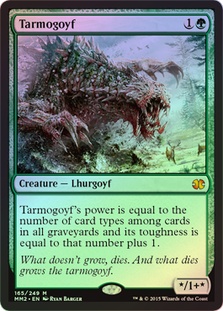 As for those foilers, Modern prices are largely unafflicted by bans. The last five cards banned in Modern flexed their dominance in shells comprised of irrefutable format staples. Deathrite Shaman’s ban didn’t weaken the stock of Abrupt Decay and Tarmogoyf, and Pod’s ban hardly dented that of Noble Hierarch and Siege Rhino. Likewise, removing Treasure Cruise, Dig Through Time, and now Splinter Twin doesn’t menace the value of Serum Visions and Snapcaster Mage.
As for those foilers, Modern prices are largely unafflicted by bans. The last five cards banned in Modern flexed their dominance in shells comprised of irrefutable format staples. Deathrite Shaman’s ban didn’t weaken the stock of Abrupt Decay and Tarmogoyf, and Pod’s ban hardly dented that of Noble Hierarch and Siege Rhino. Likewise, removing Treasure Cruise, Dig Through Time, and now Splinter Twin doesn’t menace the value of Serum Visions and Snapcaster Mage.
These cards continue to define Modern, and will likely command a premium for years to come, regardless of bans. Given that bans raise Pro Tour viewership and increase Modern buzz, Modern staples should actually increase in price, as they have for years. Financially speaking, a brief overview of Modern's banlist history actually incentivizes investing in format pillars.
This topic deserves its own article. I still wanted to mention it here, as the argument that bannings destroy the value of Modern collections doesn't hold any weight. In the name of format diversity, a possible yearly banning - backed up by data - should not discourage new players from buying into Modern.
Picking Up the Splinters
Hopefully, this article removes some stigma from the upcoming Pro Tour and gives readers a deeper understanding of the January 18th announcement. I look forward to engaging with you in the comments below, and to the exciting future of Modern. Until then, happy brewing!


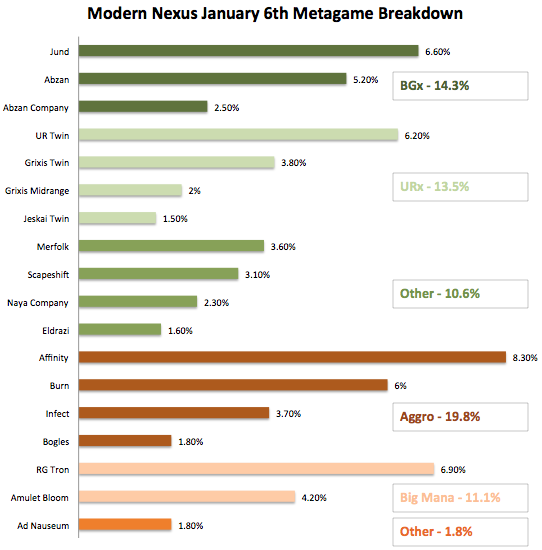
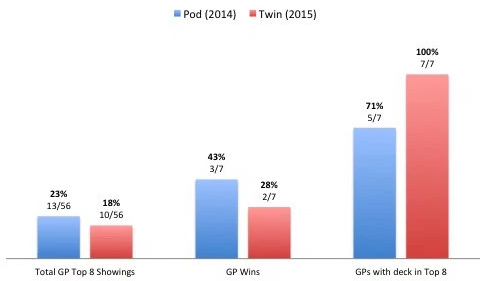


Very good article, Jordan. I was initially in shock regarding the banning, but this article elucidates the reasons why it made some sense. I think URx will be fine (LSV just put up a video for a Delver + Moon deck on ChannelFireball that looks rock-solid), especially if they do what you, I, and others predict and unshackle cards like Preordain and perhaps even Counterspell (my Merfolk deck in particular would love to have this one). I’m also looking forward to seeing if any of the linear strategies that were left on the shelf because they scooped to T3 Exarch + T4 Twin will be robust enough to stick in this new meta.
I’m sure there’s some linear strategy out there that attacks from an angle Modern players aren’t yet prepared for that failed the “but is there any reason to play this over Twin?” test. We’ll probably see one or more of these decks surface over the next few events!
I aggre!!! the format has room for new decks like this one I made… it has the same tempo UR twin has but nobody tried before because Twin existed (me also as many years twin player)! I tested this week against the current meta and has a 4 turn kill and tempo elements too 😉 tell me if you like it!!! http://tappedout.net/mtg-decks/grand-pala-combo/
It has the grand architect – pili pala combination for inifinite mana and the muddle (key of this deck for counter or transmute to snapaster, remand, pili or train)–> train of though –> zenith for finish plus the other tempo elements the original twin has… also is more advantageous in sb against jund-abzan e.t.c.
Love the article and agree with you that the Twin ban was necessary.
One thing I wanted to point out, which may just be my opinion. But isn’t Grixis Control, which you included under Homogenizing URx, technically more BRu than URb? Grixis Control seems to run a lot of Tasigur, Gurmag, Pia, (possibly Kalitas soon), Terminate, Kommand, Inquisition/Seize, Liliana, etc. Even Grixis Delver and Grixis Twin run way more blue. In which case, wouldn’t the pie chart be more accurate by excluding the Grixis Control deck? Therefore showcasing that URx Twin was completely homogenizing URx?
Otherwise, I agree with everything here.
I categorize Bolt-Snap-Bolt decks as URx. My RUG Delver builds generally only play Bolt as red cards in the main, and are way more “UG” than “UR.” But they’re still URx decks.
That’s just it, though: as far as I can see, Grixis Control started life as a classic URx deck built around Snapcaster and playing primarily at instant speed, but with the increasing prevalence of Jace has evolved into something much more like Jund – a board control deck playing mostly at sorcery speed.
Largely agree with everything here, even if I’m annoyed that Pod/TC/DRS/BBE got banned for winning too many large events and taking up an oppressive slice of the metagame, whereas Twin mostly offended in T8s alone. That said, I do want to push back about the Pro Tour and ban relationship. I think, and will argue next week, that the Pro Tour was a much larger driver of the ban than many acknowledge. It was certainly large enough that it should have been mentioned in the official announcement instead of just over Twitter.
As you correctly observe, the Pro Tour did not dictate the ban or cause it. But it certainly determined the timing of the ban and, perhaps, gave enough incentive to push Wizards over the edge on pulling that trigger. I think this factor is totally incongruent with effective banlist management and shouldn’t have been at play in the slightest. Based on this, I also think Modern should not be a Pro Tour format unless Wizards changes the Pro Tour’s goals or kicks off a new “Pro Tour” esque event just for Modern. The Modern Cup, anyone? This one conflict sours the entire ban for me, especially the oversight (or deliberate misleading) in not including Pro Tour references in the ban announcement itself.
That said, I am optimistic about the metagame’s health in 2016 and think Twin’s removal opens up a lot of room for Modern to rock. Sadly, the continued influence of the Pro Tour threatens that, and I will speak out against that whenever I can.
I’m excited to read your piece, and especially hope you include data supporting your point. I’ve read a lot already on the Pro Tour being more of a factor for this ban than it seems to me, but none of those arguments have resonated much because they aren’t steeped in facts. I’ve seen people make these arguments with words like “deliberately misleading” and “hamfisted.” That ends up losing them a lot of credibility, since such accusations don’t emerge in a structured, researched way.
I’m also curious to learn how you can categorically say the Pro Tour was so large a factor that Wizards “should” have mentioned it in the official announcement. Based on the numbers, it seems to me that the case for banning Twin, considering Wizards’ revealed metrics, is quite strong; in that case, there’s little reason to toss in another justification.
On timing: a consistent Modern banning schedule was put into place before the Modern PT was even decided on, as Corbin Holser explains in his article (linked above). If anything, it seems the PT dates were decided to fall in line with THAT schedule. Further, if Wizards realizes Twin meets the required criteria for a ban, would you prefer they ban it immediately? I know I’d want them to try printing specific answers like Rending Volley, and then give the metagame even MORE time to adapt. If things look truly bleak (like, Skullclamp-bleak) then sure, an emergency ban might be warranted. Otherwise, it makes total sense to wait until late January to announce the ban, as they have done for years. That way, players have more time to find solutions and manage the format themselves.
We also have to remember that Modern is Wizards’ format. Their ultimate stated goal for this format is diversity. Define that how you will, but I know creature decks became much more diverse in my eyes when Pod was banned. I don’t doubt that the Twin banning will have a similar effect on URx, combo, and Modern in general. If it does, we can expect Wizards to continue banning cards in this fashion, since doing so contributes to their ultimate stated goal. Time will tell!
In years, all the major bans/unbans happened exactly before modern pro tour. Maybe it’s just an appropriate timing to make pros start to solve new format environment as fast as possible whilst provide that process’ coverage with big event.
The ultimate goal is ca$h – the format was already diverse – your points are absolute garbage – you sound like a wizards shill
My exact feelings about the ban. Very well done article.
When I questioned myself why I chose U/R Storm over Twin for my first modern deck, the only reason was “budget”. I just can’t afford those damn Snapcasters. Otherwise, Twin seemed stronger because it could do a lot other things than just combo off. Surely, why play some glass canony combo that can be easily hated out if you can adjust your deck to execute any strategy your opponent is weak against with only Twin?
Well, there’s another decks out there that can play different roles throughout the game, like company with built-in infinite combo and even Kiki-Chord with several infinite combos! But these combinations sit in the less resilient shell that can be destroyed with common removal. That’s the reason those decks use Spellskite as it’s the only thing that can protect the combo if they want to go that route. Twin used countermagic, and it’s way stronger instrument for not only combo protection, but controlling the game in general.
This has been one of your best articles yet. Strong points, clear wording, and extensive use of quotes directly from Wizards ban announcements make for a compelling read. As more time passes, the less upset I feel about the ban, probably due to articles such as this that are based off of the evidence, rather than upset (and subjective) articles based off of emotions. I can’t wait to see another Temur Grow deck article btw. Fantastic job.
Temur grow is now shit as twin is not in the format – same with most blue decks
http://www.mtggoldfish.com/tournament/scg-modern-classic-atlanta#online
http://www.mtggoldfish.com/tournament/scg-modern-classic-atlanta#online
2 Temur Delver in the top 16? The tournament won by Temur Delver? Temur looks reaaall bad right now lol
Its an IQ with one of the best mtg players playing the deck – even mediocre
decks with good pilots can get there on occassion – highly unlikely to be repeated
Thanks! Agree about the upset/subjective articles. If you have friends who are really upset about the Twin ban, show them this. I think it will do the community a lot of good if we can have a level-headed discussion about the implications of Modern bannings without letting emotions muddle our logic.
Great article. While I’m on the whole less scared of the annual banlist update today than I was 6 days ago, my decision not to buy into a secondary deck this year (as had been my plan) remains unchanged. Maybe banning Twin will turn out to be a good thing, but I still feel like owning a very strong Modern deck may be a liability each year come January. I mean, read the following text (which I’ve just now made up) and tell me it doesn’t read like other WotC ban announcements:
“Over the past year, Affinity decks have surpassed every other aggressive deck in terms of metagame share and success. In order to compete, decks have been forced to dedicate almost half of their sideboard slots simply to avoid being outraced by the robots. In the interest of format health and diversity, Cranial Plating is banned from Modern”
Now I’m not saying it WILL happen, but simply that I’m very scared that it COULD happen. Also, from a financial perspective, as you say, banning Twin, just like banning Pod and Deathrite in the past hasn’t crashed the price of people’s entire decks, since those decks are filled with staples, and half (or more) of their price tag is tied to the mana base anyway, which is always going to be worth something. If Wizards ever decides to axe Plating (or Ravager or even Opal), or a Tron land, those decks pretty much become worthless piles overnight since their cards don’t see much, if any, play in other decks.
It’s sad to say, but until we get more clarity on this from Wizards, I’ll always be scared when I see Affinity make top 8, even more so when/if it wins events, and feel like I have to root against it even though I adore playing that deck, and should be glad that it gets so much better without Twin in the picture.
Affinity usually starts losing after a high-profile finish. I doubt that will change much with Twin gone. People now have extra sideboard slots, and mainboard slots, to dedicate to beating Affinity. That deck also loses to hate on a level much more significant than Twin did.
That said, I can guarantee that if Affinity wins a bunch of GPs in the upcoming ban cycle, it will take a hit from Wizards. I just don’t see that happening. And even in the case of it happening, I bet the deck will still be an aggro contender in Modern and the pieces won’t become worthless. After all, the deck wins lots of games without Plating (the obvious choice for a banning), and it’s not like there’s a shortage of good replacements (Thoughtcast, Master of Etherium, etc.).
I’m not worried that the deck won’t fold to hate if it shows up in big enough numbers (it will), I’m worried WotC will argue that people HAVE to pack hate which applies (mostly) only to Affinity, kind of like having to pack graveyard hate when Dredge was big in Legacy.
Also, having established that the deck, as strong is it currently is, folds to hate, I don’t see how it could ever hope to be a true competitor if one of its core pieces were banned. Here’s hoping that I’m wrong, and that this time next year, I can still claim to be an Affinity player in Modern!
For one, people would definitely pack LESS Affinity hate if the deck took a banlist hit. That alone might keep it viable. But we won’t know until it happens!
i’m going to disagree with a few points even though i do love the article and agree with about half of it….
twin did not have a diversity problem… i think the numbers you posted bear that out… so if we are accepting that BGx homegenizes other BGx strategies then why would the same criteria be not ok with Twin? because of the level of success?
If we look at GP top 8 results.. and my god i can’t begin to describe how bad that is but ok let’s go with it… yes Twin appeared in all 7 GP’s top 8s… they had a total of 10 appearances which was the most… but you know who was 2nd? Affinity with 9… and mind you there was an Affinity deck that placed 9th with a Twin deck at 8th at GP Pitt… and you know who was third? BGx with 6….
i understand that the combination of these raise ban flags… but that’s not really clear cut and dried is it or am i crazy? a few more appearances from BGx… and this was a rather weak year for it …. then you have just a good a case for ban of Liliana there… a couple more percentage pts in the meta for Affinity and you have just a good case for a Mox Opal ban..
This is what those decks have to contend with… a very very low bar based on criteria that might not have anything to do with their actual power level but how the meta shakes out… and Twin’s popularity always fluctuates with how linear the format becomes as this summer’s meta numbers point to…
What does this mean? It basically means they are chopping a huge piece of a popular deck every year.. in year’s past you had justification because those cards were actually broken… This year? it’s AT BEST unclear and they chopped Twin anyway… which oughta tell you what’s going to happen to Affinity/BGx/Tron next year….
The URx pillar in fact did have a diversity problem. Over 75% of all URx decks played Splinter Twin in the last ban cycle. GP Top 8s may not be a “valuable” statistic for you, but it’s clearly one for Wizards. They’re the ones in charge of the banlist, so it’s silly not to pay attention to those numbers going forward.
We also know from their conservative unbans that Wizards doesn’t want to make too many changes to Modern at once. It’s possible that Affinity’s numbers from the last ban cycle meet their criteria for a banning, too (although I doubt it, for reasons I won’t go into here. Not a lot of point in discussing these IMO). Still, Twin was a larger offender in their eyes, and according to the numbers, and certainly met more criteria than Affinity. Wizards wouldn’t want to ban cards from two decks at once, so they stuck with the primary offender.
If Affinity also met their criteria, though, and it repeats its success during the next ban cycle without a contender to beat its numbers, it will definitely get banned. That said, I don’t think it does meet the criteria. I think Affinity will have to do better than it did last cycle to receive a ban, and it will also need to do better than every other Modern deck. Given how easy it is to hate out, and the fact that it’s a known quantity, I don’t see this happening. But it could!
“The recent breakdown numbers initially suggest Rock decks revolving around Liliana of the Veil and Abrupt Decay homogenize BGx as much as Splinter Twin homogenizes URx.”
as you alluded to there are other factors involved… and i know your main point is that it’s the combination of the diversity problem plus the success that leads to a problem with Twin… but my contention is that there are other decks with indistinguishable differences based off of WotC’s own parameters… diversity and top 8 appearances…
it truly isn’t going to take much for Affinity or BGx to get the banhammer also… and i don’t see the benefit to either banning just as with Twin… so i pose the question: Are arbitrary ban parameters good for the format? my answer is unequivocally…. no….
Over 100% of BGx decks player Lili, over 100% of Affinity decks play cranial plating, over 100% of Tron decks play Ulamog – please, go away – modern nexus going to new lows
Stop…using…ellipses…! I cannot read what seems like a good post.
Yeah… This. Player confidence in the format has taken a huge hit, one that would take a long time without arbitrary banning to be restored. Simply put, the deck that wins the most will be banned, and that means modern is effectively a rotating format.
Beyond that, one argument that I seldom see addressed is that the modern metagame is much worse without twin in it now. Look at that act classic top 8… 2 tempo decks, 1 midrange, 12 aggro decks. Barely any interaction. This is not what a healthy metagame looks like, and barring some incredible tech at the pro tour, that’s what we’re left with for at least three months, and likely an entire year with a completely linear metagame. Sounds fun.
You and Trevor should make love and have a baby called we have no idea what we are talking about.
“In the interest of WOTC bottom line, Splinter Twin is banned from Modern.”
As someone who has played around extensively with a variety of URx decks, I can tell you that in the past four years or so, Twin is the only one I’ve found viable not because the Twin package is so enticing, but because it’s the only way to build URx that isn’t below the bar for viability in the format. In other words, I didn’t end up preferring Twin to Delver or Grixis Control or whatever you want to point to because I thought “this would be better with Twin in it”; I preferred Twin because Twin could actually win a decent percentage of the time against a decent percentage of the field, whereas Delver and Grixis (and Esper, RUG Mid, monoblue and blue-black faeries, etc. etc.) are all decks with like a 40-45% win rate vs. the field. (Not exact numbers, but illustrating a point, in the same way as GBx tends to be 50-55% against the field.)
Of course, for any aggressive blue-based deck or any three-colored fair deck, the #1 thing you were hoping to play against was specifically Twin, since the matchup was favorable, so now other than preference there’s very little reason to play the shell at all. If your objective is to maximize win rate, URx is effectively dead right now, unless the metagame shifts in some very bizarre ways. All of your build options are just underwater as far as winning chances in an open field go.
The thing is, the other blue decks that exist are just really bad. Have you tried playing them? They get smashed by turn 3 combo decks all day long and I think in modern, you HAVE to have a good combo matchup to have a viable deck.
I don’t personally think Modern has the tools necessary to keep the format from becoming about racing to a turn 3 kill. Other people I’ve talked to say this won’t be an issue, but I’ve never gotten a legit answer to this concern, just a handwave. Having a hyper linear metagame may not bother you that much, but I find it a concern. So, what reason is there to assume modern will have any interactive decks remaining in the format?
Yep, I have tried playing them! I’ve written quite a few articles on non-Twin blue decks and have had some significant success with them. You can actually find the articles on this very website. For the record, Delver decks do a great job policing linear strategies in Modern.
That’s why Delver decks keep losing, right?
Agreed.
I think the current pool of spells is not enough to push a true blue based control deck.
While the article does point out that many control options were banned, or simply not valid in modern, primarily because of twin (which I do agree), I hardly think Wizards will release then just because twin went away.
I think the meta will be “healthy” in the sense that a lot of decks will be in the field but I believe most of then will be linear non interactive decks racing to see who kills or shuts the other faster.
Pairings (as of matchups) and die rolls will be as important as ever.
We’ll see! If URx is as bad as you guys think, I’m sure Wizards will throw it a bone.
I agree with everything that you have said Jordan. URx i believe had a very rough time with Twin in the field, now that it is gone i have seen the following decks rising to power: TRON & TEMUR DELVER.
Temur Delver decks around here seem to be bringing a lot of land hate in the form of Stone Rain/Molten Rain with a bunch of Blood Moons in the sideboard to fight the Tron match up. I could see BGx bringing a bunch of Choke to fight Delver, with Fulminator Mage’s for Tron.
Personally i can’t wait to try out this Stormchaser Mage in a URx shell, he just seems like a beast.
Thanks for the article, i do enjoy Modern Nexus for every article that contains facts/statistics.
I’m also very excited for Delver decks in the coming metagame! Thanks for the kind words. I think it’s very important to consider the actual data for issues like these, or else people let their emotions get the best of them and say really embarrassing things.
Why – they were best when Twin was in the format due to the great matchup they had – the idea that RUG delver is now somehow good is fanciful. Sure ppl will play the deck and may even have some success at IQ level but they cant compete in any decent event as they are too inconsistent (delver flipping, removal heavy decks shit in this deck )
Some of the points in this article are interesting, but to say that twin being banned was not because of the pro-tour is very naive. How can one have concrete proof if I am not sitting in wizards board room. Here is the plain and simple folks:
Wizards is hosting a PROMOTIONAL TOUR for a format that won’t be promoting their new cards from OATH. Since that is the case, Wizards looks at the last 4 modern pro-tours. Splinter twin has one 2 of them. If twin were to win again, then everyone would jump ship and say that twin is the best deck, the format is boring/solved. So does wizards take a chance that happens or do they make a ban that makes a non-boring pro-tour? The latter. plain and simple. They have even said this so no point in saying that isn’t the case.
I don’t think Wizards is bad for this decision per say. Modern has been a very successful format. I think the people that brewed up Modern wanted us to have a nice bridge from standard rotations so that we could continue to play with pet-cards/decks or to have something else to play that makes our cards not tank in value. Modern has very successfully done both these things. As a result of Modern, older cards from older sets have retained value and it gives me something to play. So I doubt that the people that brewed up a Format really want to ban cards that make our decks unplayable. That is why they axed the Modern promotional tour, because some people knew what this would entail.
However, since the community threw a shit-fit about it, they brought the pro-tour back and with that comes bans. You can’t have a non-rotating format be completely diverse and new when the power level of legacy isn’t there. I bet if we had a legacy pro-tour the format would reveal some not so pleasant things for format. Point I am trying to make: When wizards hosts a promotional tour, they are saying this. ” We are going to throw a bunch of money out there and whoever figures out this format or the current metagame will be highly rewarded.” This works great for standard since you cycle sets in and out, this promotes new cards from new sets and when a format is starting to get stale, something old goes out and something new comes in, rinse repeat.
This works terrible for a non-rotating eternal format for all the reasons we are seeing. Given enough time and incentive, people are going to figure out a non-rotating format without powerful catch-all cards. Modern has a big card pool but it is limited. So since a lot of people wanted to see pro players playing modern decks the format has essentially been solved in the past 4 years. So wizards either runs a “boring” pro-tour or they do what they can to shake it up.
The community has to realize that pro-players will actually ruin a non-rotating format if you give them enough time. And by ruin, they will solve it, and there will be a clearly established meta. I would say that modern has about 4-6 viable decks that are actually strong enough to win a grand prix. Legacy has some clearly established strong decks, but you have such a strong format that there are not that many terrible matchups and more than not, each matchup is very interactive and fun to play. I can’t say that much about modern. Please community, throw the shit-fit you are capable of and end the annual modern pro-tour. It will kill the format given enough time.
Well, we don’t have hard proof that Twin was banned because of the Pro Tour. We do have an official explanation from Wizards that actually makes a lot of sense if you check out the numbers. I’ve laid them out above if you want to give them a look!
I have to comment on the opinion that twin was oppressive for URx strategies. URx strategies are very weak compared to what the rest of the field was doing. Splinter twin allowed urx to basically have a fighting chance.
Making the case against affinity is very strange to me. Look at the hate that has been printed to stop affinity. Stony Silence, ancient grudge, shatterstorm and creeping corrosion, destructive revelry, nature’s claim to name a few.
Affinity has a ridiculously high game 1 win %. If it wasn’t for these insane hate cards and the fact that decks need to run at least a 1/4th of their sideboard with some combo of those cards to have a chance speaks pretty loudly for how strong affinity is. Should it be banned though? NO. Stop trying to neuter modern into standard 2.0. The point is there are plenty of strong hate cards for twin, just because people can’t play uninteractive linear strategies and get away with it doesn’t mean the deck was oppressive. Stats clearly show it wasn’t. The gp top 8’s is such a terrible indication, don’t even go into the other decks that were making up a larger %
I guess you truly see what you want to see and believe what you want to believe.
All I ever hear people say is what cards to ban next. I don’t want an eternal format where all we do is ban the best deck every year. What fun is that? Look at Modern in 4 more years at the rate we are going. Take 4 random tier one decks out and look what you are left with. Ask yourself if that format looks fun to you.
Wizards has said in the past, and on this banlist announcement, that they look to GP Top 8 slots as an indicator of format diversity. Whether you agree with them or not, that’s just what they do. It would be short-sighted of us not to consider, then, Twin’s GP Top 8 appearances this season – which are higher than any other deck’s. Posts like these make me wonder if people even read Wizards’ banlists announcements.
Pretty sure we do mate – have you been hiding under a rock and/or a Wizards shill?
So Jordan, you agree that we should just be happy with 1-2 main cards from tier 1 decks getting banned each year?
You agree with the statement that the pro-tour has absolutely nothing to do with the fact that cards get banned?
It’s posts like yours that make me wonder if you look further into the equation or if you just blindly accept everything wizards tells you as gospel truth.
So why hasn’t wizards banned sensie’s top or counterbalance from miracles? Or in fact why hasn’t brainstorm been banned? Based on numbers and event wins and top 8’s that deck has been the most successful. Brainstorm makes its way into 70% minimum of all top 8 decks being a 4 of.
It hasn’t been banned because A. It doesn’t need to be and B. BECAUSE LEGACY HAS NO PRO-TOUR. If legacy had a pro-tour, do you think that brainstorm or miracles would be banned ?
So you agree that we should just be happy with 1-2 main cards from tier 1 decks getting banned each year?
You agree with the statement that the pro-tour has absolutely nothing to do with the fact that cards get banned?
It’s posts like yours that make me wonder if you look further into the equation or if you just blindly accept everything wizards tells you as gospel truth.
So why hasn’t wizards banned sensie’s top or counterbalance from miracles? Or in fact why hasn’t brainstorm been banned? Based on numbers and event wins and top 8’s that deck has been the most successful. Brainstorm makes its way into 70% minimum of all top 8 decks being a 4 of.
It hasn’t been banned because A. It doesn’t need to be and B. because legacy has no PRO-TOUR. If legacy had a pro-tour, do you think that brainstorm or miracles would be banned ?
I think if those decks are putting up numbers that resemble those of cards that have already been banned, there’s no reason for us to be surprised at a banning, at the very least. Wizards thinks banning in this way increases format diversity, and so far, they’ve been correct.
Banning cards probably has something to do with the Pro Tour, but we don’t have any hard evidence that this ban was based mostly on the Pro Tour. In fact, we have evidence that this ban was based mostly on other factors.
Wizards constantly bans cards from Modern “in the interest of format diversity.” It’s plainly obvious to me that “format diversity” is not something that’s tremendously important to Wizards in Legacy, otherwise they would ban Brainstorm.
So you are fine with all of moderns top tier decks becoming non-existent or just weaker versions of their former self. That is sad.
The results of a deck getting top 8 vs top 16 are what? 1-2 wins or losses? What a crazy difference that is. Top 8’s alone are a terrible metric to base a banning off of.
Read Tom LaPille’s explanation’s on reddit or listen to the podcast he was on. Look for yourself on mtgtop8.com and look at the % of players playing each deck. Those numbers right there tell you twin isn’t oppressive. Jund and Junk decks have consistently held more meta % than any other deck.
Look at the stats for last years pro-tour fate reforged. PVR so kindly put those on one of his articles. Look at the “diversity” there and and in any of the previous sites I mention and tell me that diversity is an issue. It isn’t. Saying anything else is just a stubborn denial of the truth.
Point is, the pro-tour is killing modern as a fun format to play. It is and will continue to ruin the game for the casual players, the people who just want to play at their local game stores, fnm, and if everything aligns maybe a grand prix or some side events when they can attend.
I will continue to fight for the health of modern as I see it as nice format to play once one is done with standard, or needs a break of standard or whatever their reason is. If you are under the false assumption that banning cards every year from a top tier deck is good for format diversity, then you will be very dissapointed in the format in 4 years.
When Wizards puts the utmost consideration into top8s at large tournaments, hen looking the Modern Nexus metagame doesn’t give a lot of insight into whether a deck deserves to be banned. So while Twin may not have had the largest share in the metagame as a whole(and nowhere near pod/delver/jund shares of metas past) using the Nexus method of measuring metashare, this metric as a whole is largely irrelevant when talking about whether a deck is getting too large a piece of the metagame pie.
As for Splinter Twin suppressing diversity within URx strategies, unless some URx decks surfaces in the post-ban metagame, then Splinter Twin was if anything the reason that URx saw some amount of play. At which point the card wasn’t hindering in-colors diversity but actually what made it competitive.
Without twin i suppose aggro decks are going to show more, as the only real control deck is basically gone. They also printed eldrazi with cast effs (Remand, laughing at you). This means a less complicated metagame, more like a vanilla-only beaters decks.
Also, Kiki-jiki can’t be used ad replacement of twin: one more red mana, creature, 2/2. Either you have protection, and combo off turn 6 at least, or kiki get killed. Everyone knows that, but saying to new players who bought Into twin that their deck is gone and they have spent money on something that won’t see play anymore sounds bad.
Wizards is really thinking only about money: they printed twin in mm2, let people buy Into a deck. Then banned it. What they call a more diverse format, is an excuse for lowering the play level so that less competitve decks can see play. Decks which are going to use newer cards. See the new ur creature with prowess: twin ban with the immediate release of this mage, intended for ur aggro lists. Twin players players that cannot buy Into something else are going to play ur delver lists. Coincidence? I don’t think. Wizards is caring only about money? It seems.
I know that I’m late to the party but I really enjoyed this article. I feel as though every player who has taken up arms about the ban should read this because you are the well spoken voice of reason.
I agree that the ban of twin might lead to the unbanning or modern-legal printing of some of mtg’s more powerful blue spells like Preordain or Counterspell. I truly hope that Wizards is considering doing this because I feel as though it would greatly improve the format.